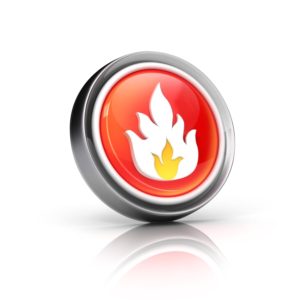
How To Use A Fire Extinguisher – Fire extinguishers are an integral part of today’s fire safety gear everywhere. However, if you don’t exactly know how to use one, this lifesaving tool could be rendered null and void in the stressful air of an impending emergency. Don’t be caught off guard, and always remember the fire safety industry’s key term “PASS” when it comes to operating a fire extinguisher at any time in the future. PASS works as follows. Click here for the Best-Selling Fire Safety Products.
P for “Pull”
At the first sign of an extinguishable fire, remember the letter P. P here stands for “pull” which represents the first action you need to take once the extinguisher is in your hands. With the nozzle facing away from you, pull the safety pin that prevents the trigger from being squeezed in accidental cases. This pin typically resembles a loop with a shaft that is lodged into the trigger in some way. Firmly pull or yank this pin out, and get ready for the next step.
A for “Aim”
Next, you will need to aim the extinguisher’s nozzle directly at the base of the fire. Aiming efficiently is important, as you will only have a limited supply of extinguishing material to work with in the extinguisher. Aim at the base of the fire specifically, as this is the actual origination point of the resulting fire and flames.
S for “Squeeze”
After getting your aim lined up, the next critical step in the extinguishing process is to squeeze the trigger. In fire extinguishers, the “trigger” as we refer to it may resemble the typical gun-style trigger, or it may simply take the form of a handle that you squeeze with the whole hand. Identify and squeeze the trigger while remaining steadily aimed at the fire’s base.
S for “Sweep”
Finally, you’re ready for the firefighter’s finishing move: the sweep. While squeezing the trigger and maintaining aim at the fire’s base, begin to use a steady, back-and-forth, sweeping motion in order to hit all areas of the fire’s base with the extinguishing material. Repeat studies have shown that sweeping is better in most cases than stationary extinguishing, because it more thoroughly covers the source of the fire.
Some Additional Notes
Now that you know the industry’s standard “PASS” method, you’re as ready as ever should you need to employ one of these incredibly important tools. In addition to knowing the PASS method, though, there are a few, additional facts that are helpful if not crucial to keep in mind regarding fire extinguishers and their effective use. When it comes to your fire extinguisher, consider the following, important facts.
- There are three, primary types of fires, and fire extinguishers are rated for those specific fire types. Most fire extinguishers, however, are rated “ABC” for effective suppression of any of the three fire types:
- “A” fires are those involving typical, solid materials such as wood, paper, and plastics.
- Class “B” fires are those primarily consuming liquids such as cooking grease, gasoline, or other, flammable liquids.
- Class “C” fires are those produced by live electricity.
- Fire extinguishers expire. Any time one is used or is damaged somehow, that fire extinguisher is considered expired and not adequate or safe for future fire suppression efforts. Fire extinguishers also come filled to a certain, ideal operating pressure which they can lose over time. If a fire extinguisher’s attached pressure gauge shows it in a low pressure state, it is expired and should be replaced as soon as possible.
- All fire extinguishers come with some basic correspondence and attached instruction tags. It is always best to familiarize with this documentation and to also be familiar with the extinguisher model you have on hand.
- Unfortunately, while highly effective in most, small fire situations, fire extinguishers do come with a few, inherent limitations. One of these is the fact that they only typically put off about 10-25 seconds worth of extinguishing spray. Another, slight limitation comes in the fact that extinguishers typically only spray at a distance of about 10-15 feet on average.
Whether you’re on the road, at home, or in the office, having a fire extinguisher nearby can save lives and entire structures. This is especially the case when you know the basics of how to use one. Remember the PASS method, and you’ll always be as ready as ever. In conclusion, for those looking for additional resources on fire extinguisher use or fire safety in general, the National Fire Protection Association as well as the American Red Cross are excellent organizations with which you are recommended to inquire further.